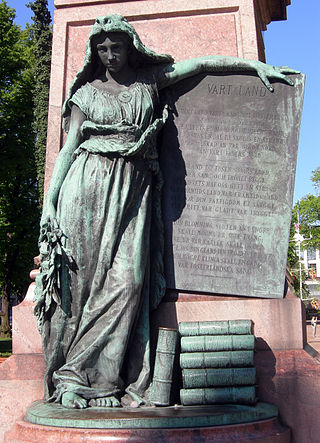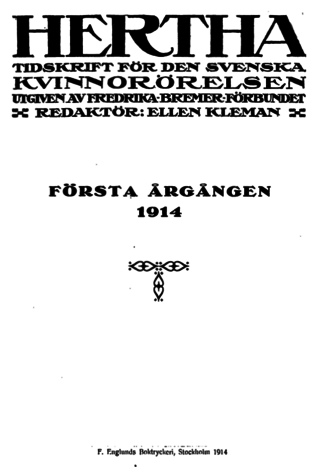Related Research Articles
The term postfeminism is used to describe reactions against contradictions and absences in feminism, especially second-wave feminism and third-wave feminism. The term postfeminism is sometimes confused with subsequent feminisms such as fourth-wave feminism and xenofeminism.
Lipstick feminism is a variety of feminism that seeks to embrace traditional concepts of femininity, including the sexual power of women, alongside traditional feminist ideas. The concept emerged within the third-wave as a response to ideals created by previous movements, where women felt that they could not both be feminine and a feminist.

Alexandra Gripenberg, also known as Alexandra van Grippenberg, was a Finnish social activist, author, editor, newspaper publisher, and elected politician, and was a leading voice within the movement for women's rights in Finland at the turn of the 20th century. She was also known as a Fennoman.

The Nordic model comprises the economic and social policies as well as typical cultural practices common in the Nordic countries. This includes a comprehensive welfare state and multi-level collective bargaining based on the economic foundations of social corporatism, and a commitment to private ownership within a market-based mixed economy — with Norway being a partial exception due to a large number of state-owned enterprises and state ownership in publicly listed firms.
State feminism is feminism created or approved by the government of a state or nation. It usually specifies a particular program. The term was coined by Helga Hernes with particular reference to the situation in Norway, which had a tradition of government-supported liberal feminism dating back to the 1880s, and is often used when discussing the government-supported gender equality policies of the Nordic countries, that are linked to the Nordic model. The term has also been used in the context of developing countries where the government may prescribe its form of feminism and at the same time prohibit non-governmental organizations from advocating for any other feminist program. In this sense it is possible to distinguish between a liberal state feminism found in Western democracies such as the Nordic countries, and a somewhat more authoritarian state feminism that is often also linked to secularism, found e.g. in certain Middle Eastern countries.

Women in Finland enjoy a "high degree of equality" and "traditional courtesy" among men. In 1906, the women of Finland became the first women in Europe to be granted the right to vote. There are many women in Finland who hold prominent positions in Finnish society, in the academics, in the field of business, and in the government of Finland. An example of powerful women in Finnish politics is Tarja Halonen, who became the first female president of the country. In religion, where most of the Finnish people are members of the Evangelical Lutheran Church of Finland, women can be ordained as priests. In terms of finance, Finnish women have been described as "usually independent financially". The Telegraph wrote in 2006:
Finnish women are much more outgoing and approachable than the men and often command three or four languages. Their position in society and business is well-respected and superior to that of women in most other cultures.
Gender plays a role in mass media and is represented within media platforms. These platforms are not limited to film, radio, television, advertisement, social media, and video games. Initiatives and resources exist to promote gender equality and reinforce women's empowerment in the media industry and representations. For example, UNESCO, in cooperation with the International Federation of Journalists, elaborated the Gender-sensitive Indicators for Media contributing to gender equality and women's empowerment in all forms of media.

The socio-political movements and ideologies of feminism have found expression in various media. These media include newspaper, literature, radio, television, social media, film, and video games. They have been essential to the success of many feminist movements.
Me Naiset is a Finnish language women's magazine published in Helsinki, Finland. It is one of the largest weekly women's magazines in the country and has been in circulation since 1952.
Kotiliesi is a bimonthly family and women's magazine published in Helsinki, Finland. Founded in 1922, it is one of the oldest magazines in the country and is the first Finnish magazine addressing housewives.
Feminist children's literature is the writing of children's literature through a feminist lens. Children's literature and women's literature have many similarities. Both often deal with being seen as weak and placed towards the bottom of a hierarchy. In this way feminist ideas are regularly found in the structure of children's literature. Feminist criticism of children's literature is therefore expected, since it is a type of feminist literature. Feminist children's literature has played a critical role for the feminist movement, especially in the past half century. In her book Feminism Is for Everybody: Passionate Politics, bell hooks states her belief that all types of media, including writing and children's books, need to promote feminist ideals. She argues "Children's literature is one of the most crucial sites for feminist education for critical consciousness precisely because beliefs and identities are still being formed". The cover of hooks' book, drawn by Laura DeSantis, depicts children alongside adults, showing the importance of the youth. The presence of feminism in children's literature has evolved over the years, but the overall message and goals have remained consistent.

Women in Iceland generally enjoy good gender equality. As of 2018, 88% of working-age women were employed, 65% of students attending university were female, and 41% of members of parliament were women. Nevertheless, women still earn about 14% less than men, though these statistics do not take into account the hours worked, over-time, and choices of employment. Iceland has the world's highest proportion of women in the labour market and significant child care allocations for working women. It has gender neutral parental leave, with a quota for each parent, and a transferable part.
Uusi Nainen was a Finnish communist women's magazine published in Helsinki, Finland. The magazine existed between 1945 and 2008.
Aatami was a Finnish language men's magazine that was in circulation between 1944 and 1954 and was the first magazine specifically targeted male readers in Finland. The first issue appeared in December 1944. The magazine considered its readers as fellow soldiers who returned home from World War II and now attempted to create a peaceful society in Finland. However, if the soldiers committed crimes, Aatami called them hooligans who were not genuine frontline soldiers.
Kansa Taisteli was a monthly men's magazine which featured articles on the memories of the war veterans. The magazine published in Helsinki, Finland, in the period 1957–1986. It was the Finnish version of Landserheft, a German magazine.
Für Dich was a weekly women's magazine published in East Germany and then in Germany following the unification. It was the only publication in East Germany which specifically targeted women. Official description of the magazine in 1988 was "illustrated weekly magazine for women, with contemporary political, economic and cultural contributions." It was in circulation between 1946 and 1991.
Koti ja Yhteiskunta was a monthly women's magazine which was published in Helsinki in the period 1889–1911. It was the official media outlet of the Finnish Women’s Association.

Hertha is a Swedish-language women's magazine published by the Fredrika Bremer Association, named after Swedish writer and feminist Fredrika Bremer's novel Hertha. It has been in circulation since 1914.
Tiden is a quarterly theoretical political journal published in Stockholm, Sweden, since 1908. It is organ of the Social Democratic Party. Its original subtitle was Tidskrift för socialistisk kritik och politik which is later changed to Socialdemokratisk idé- och debattidskrift.
Kirsti Lyytikäinen was a Finnish businesswoman, publisher and journalist. She was one of the owners and a long-term board member of the A-Lehdet publishing company and served as the editor-in-chief of the magazines Anna and Hopepeili.
References
- 1 2 3 4 Erkka Railo (2014). "Women's Magazines, the Female Body, and Political Participation". NORA - Nordic Journal of Feminist and Gender Research. 22 (1): 49. doi:10.1080/08038740.2013.869620. S2CID 143690762.
- 1 2 3 4 Heidi Kurvinen (2015). "Global ideas in local media: Negotiating the Ideas of Gender Equality in a Finnish Women's Magazine—The Case of Anna, 1965–1970". In Yulia Gradskova; Sara Sanders (eds.). Institutionalizing Gender Equality: Historical and Global Perspectives. Lanham, MD: Lexington Books. p. 23. ISBN 978-1-4985-1674-7.
- 1 2 Laura Saarenmaa (2013). "The Cosmopolitan Imagination in the Cold War Context: Finnish Fashion Models and National Fantasies of International Success". Fashion Theory . 12 (3): 322. doi:10.2752/175174113X13597248661783. S2CID 146295117.
- 1 2 Susanna Fellman; Pirkko Leino-Kaukiainen (2006). "Business or Culture? Family Firms in the Finnish Media Business in the 20th Century". Scandinavian Economic History Review. 54 (3): 256. doi:10.1080/03585520600973618.
- ↑ "anna". Otava Media. Retrieved 21 August 2021.
- ↑ Laura Saarenmaa; Iiris Ruoho (2014). "Women's magazines in the Nordic style: Politics, politicians and the welfare state". European Journal of Communication . 29 (3): 297. doi:10.1177/0267323114523887. S2CID 144485316.
- 1 2 Johanna Leinonen (Summer 2017). "Hierarchies of Desirability: Racialized Cartographies in Media Discourses on Relationships between Finns and Foreigners (1982–1992)". Scandinavian Studies. 89 (2): 221. doi:10.5406/scanstud.89.2.0217. S2CID 165809208.
- 1 2 "Journalisti-lehti: Annan toimittaja haluttiin sivuun". Helsingin Sanomat (in Finnish). 24 May 2013. Retrieved 25 August 2021.
- ↑ "Ulla-Maija "Uma" Aaltonen on kuollut". Yle Uutiset (in Finnish). 14 July 2009. Retrieved 21 August 2020.
- ↑ Kaisa Nykanen; Tarja Suominen; Merja Nikkonen (2011). "Representations of hysterectomy as a transition process in Finnish women's and health magazines". Scandinavian Journal of Caring Sciences . 25 (3): 610. doi:10.1111/j.1471-6712.2010.00861.x. PMID 21244456.